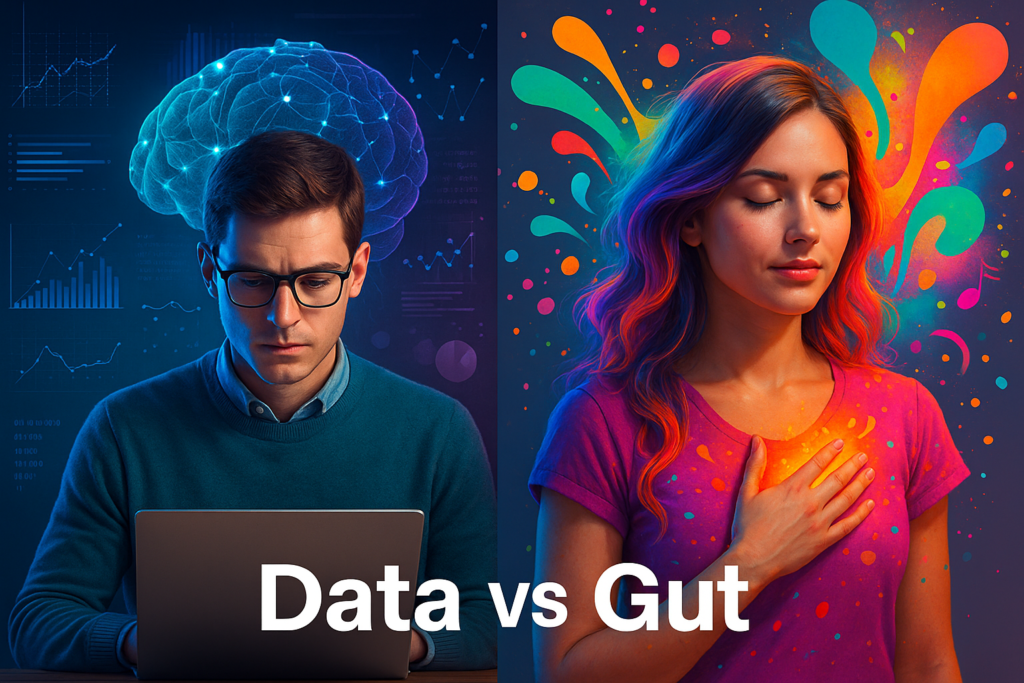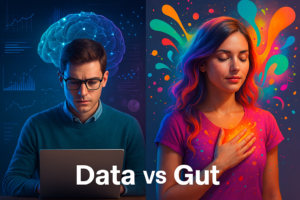
For years, marketing ran on instinct. The Mad Men era celebrated taste, intuition, and bold judgment; often glorifying the creative gut over any kind of evidence. Decisions were made in smoke-filled rooms, guided more by swagger than substance.
And for good reason, we evolved beyond that.
We recognized the risks of unchecked subjectivity, the missed signals, the cultural blind spots, the costly misfires. So we turned to data. Numbers. Models. Dashboards. The promise of clarity and control. But somewhere along the way, we didn’t just embrace data. We began to worship it.
We swapped one kind of faith for another — trading gut feeling for spreadsheets, and treating metrics like gospel. Ironically, data has become the new intuition: comforting, authoritative, and dangerously seductive.
And now, with AI accelerating our ability to process infinite amounts of data at unimaginable speed, the temptation to turn off our judgment will only grow. The risk isn’t just blind faith in data — it’s blind faith at scale.
We used to trust our guts. Now we trust algorithms we barely understand.
The Illusion of Objectivity
Data doesn’t lie. But people do — especially to themselves. (And I’ve seen this play out more times than I’d like to admit.)
We curate what we measure. We frame what we see. We bend data to our will and cherry-pick what fits the story we want to tell. As economist Ronald Coase famously said, “If you torture the data long enough, it will confess to anything.”
Nowhere is this more evident than in how we treat consumer research. We treat focus groups and surveys as definitive proof, even when we know how flawed they can be. The methodologies are imperfect. Our biases creep in. And consumers, frankly, often don’t know what they want or struggle to express it in artificial settings. Worse, they try to be helpful — telling us what they think we want to hear.
Yet instead of challenging the limitations, we over-rely on the results — mistaking data collection for actual insight.
Sometimes, the smartest move is not to listen to consumers — at least not literally. Great marketers don’t just report what people say. They interpret what people mean — even when the data tries to tell a simpler, safer story.
We’ve turned data into a security blanket. It feels scientific. Impartial. But it’s not. It’s a mirror, and too often, it reflects our own biases back at us, only now with the illusion of legitimacy.
Worse, it gives us permission to stop thinking — to follow numbers instead of leading with judgment.
The Dashboard Delusion
We’re drowning in dashboards. NPS. CTR. ROAS. Engagement curves. Sentiment waves. Heat maps. Conversion funnels. We stare at them like they hold divine truth — as if insight can be summoned through sheer volume of metrics.
But the more data we track, the less we seem to understand the people behind it.
Marketing has always been about human behavior — and human behavior is anything but tidy. It’s emotional, inconsistent, irrational, and gloriously complex. But data wants to flatten it out, clean it up, and turn it into a neat, upward trend line.
In doing so, we lose the nuance. And sometimes, the truth. We start managing the numbers, not the brand.
When Data Becomes an Excuse
One of the most dangerous uses of data is as a shield — a way to justify playing it safe.
“The data didn’t support it.” “The model says it won’t perform.” “We tested it and it didn’t move the needle.”
And just like that, brave ideas die.
I saw this firsthand while working on a redesign for an iconic baby food brand. We had developed a fresh, modern label and logo — something more aligned with today’s parents, bolder and future-facing. But the testing process was so dissected, so risk-averse, that every edge got smoothed out. The feedback was interpreted with surgical caution. No one wanted to take a chance. The result? A design that looked remarkably similar to the old one. It technically “tested fine,” but creatively, it was a complete retreat. Data didn’t lead us forward — it gave everyone permission to stand still.
We forget that many of the most iconic, culture-shaping campaigns weren’t “data-proven.” They were data-informed but courage-led. They came from teams willing to take smart risks, backed by judgment, not just analytics.
Today, we ask data to make the decision — not support it. We expect it to predict the future, remove uncertainty, and absolve us of responsibility.
That’s not strategy. That’s abdication.
The False Precision Trap
We measure what’s easy, not what matters.
Click-through rates, bounce rates, impressions, dwell time — metrics that offer the comfort of precision but often lack real meaning. We optimize for what we can count, instead of what counts.
We ask, Did they click? but not Why? We report reach, but don’t ask if we actually made people care. We chase statistical significance and forget emotional significance.
Modern marketing is suffering from a dangerous illusion: that the more granular the data, the smarter the decision. But precision isn’t the same as relevance. Just because it’s measurable doesn’t mean it’s meaningful.
In Praise of Judgment
This isn’t an argument for going back to gut feel. It’s a call to restore judgment — real, informed, human judgment — to its rightful place in marketing.
Yes, use data. But interrogate it. Challenge it. Don’t just ask what the numbers say — ask what they mean. Cross-examine data like a witness, not a prophet. Let it inform your decisions, not dictate them.
Because context beats charts. Empathy beats Excel. And no dashboard will ever replace the ability to understand culture, emotion, and meaning.
The best marketers know this. They don’t outsource thinking to tools. They use tools to think better. They don’t treat data and intuition as rivals — they treat them as powerful allies. One grounds you in evidence. The other gives you vision, taste, and courage.







